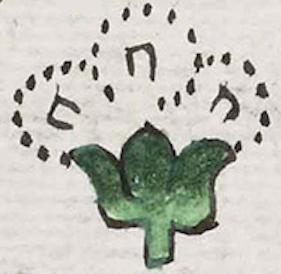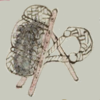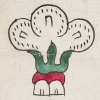ichcatl (Mdz40r)
This simplex glyph standing for the place name Ichcatlan also doubles as the glyph for a white cotton flower (or cotton boll), ichcatl. The boll (as it is called by Berdan and Anawalt, 1992, vol. 2, 159) has three fluffy tufts, a green base, and a green stem.
Stephanie Wood
The cotton boll has u-shaped markings that are reminiscent of the u-shapes in the cotton fillet (as Berdan and Anawalt call it) that has been prepared for spinning. It is worth investigating whether the u-shapes could be seeds (which the dots surely are). Such markings run through tlalli and milli, agricultural fields, too. This may be iconography for agriculture.
Spinning and weaving cotton were the domain of women. Cloth was like a currency, and both cloth and bales of cotton were some of the tribute items collected in kind, as pointed out by Berdan and Anawalt, Codex Mendoza, vol. 2, 159.
Stephanie Wood
Stephanie Wood
c. 1541, but by 1553 at the latest
Stephanie Wood

ichca(tl), cotton, https://nahuatl.wired-humanities.org/content/ichcatl
cotton boll
Stephanie Wood
Codex Mendoza, folio 40 recto, https://digital.bodleian.ox.ac.uk/objects/2fea788e-2aa2-4f08-b6d9-648c00..., image 90 of 188.
The Bodleian Libraries, University of Oxford, hold the original manuscript, the MS. Arch. Selden. A. 1. This image is published here under the UK Creative Commons, “Attribution-NonCommercial-ShareAlike 3.0 License” (CC-BY-NC-SA 3.0).



